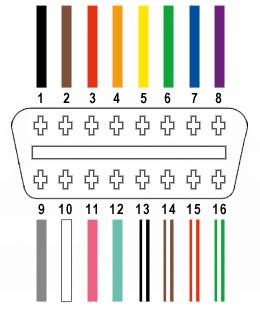Connecting your car’s OBD2 port to your computer opens a world of diagnostic possibilities. With a simple Diy Obd2 To Usb adapter, you can read and clear error codes, monitor real-time data, and gain valuable insights into your vehicle’s performance. This guide provides a step-by-step approach to building your own adapter, even with limited technical expertise.
Gathering Your Tools and Materials
Before diving into the build, ensure you have the necessary tools and parts:
- Tools:
- Wire strippers/cutters
- Needle-nose pliers
- Soldering iron (highly recommended)
- Molex crimping tool (optional, but helpful)
- Parts:
- 4-pin connector (22-16 AWG pin/wire size, 1.3-1.7mm insulation/seal size)
- OBD-II Cable (female connector)
You can purchase a pre-made OBD2 cable with pigtail wires or source individual wires and a connector separately. Knowing the wire gauge is crucial for selecting the correct 4-pin connector.
Identifying the Essential OBD2 Pins
A standard OBD2 connector (OBD2C) has 16 pins, but only four are needed for this project:
- Pin 4: Chassis Ground (Orange wire)
- Pin 6: CAN High (J-2234) (Green wire)
- Pin 14: CAN Low (J-2234) (Brown with white stripe wire)
- Pin 16: Battery Power (Green with white stripe wire)
Building the DIY OBD2 to USB Adapter: A Step-by-Step Guide
Step 1: Preparing the OBD2 Cable
Remove the outer sheath and shielding from the OBD2 cable, exposing the individual wires. Separate the four necessary wires (pins 4, 6, 14, and 16) and secure the remaining wires with a zip tie to prevent interference.
Step 2: Prepping the Wires for the 4-Pin Connector
If the wires from your OBD2 cable are thinner than the 4-pin connector’s pin size, you may need to “thicken” them. Strip approximately 3/8″ of insulation, fold the exposed wire over, and twist it tightly. Slide a rubber seal (included with the 4-pin connector) over each wire.
Step 3: Connecting the Wires to the Pins
Insert the exposed wire into the front prongs of the 4-pin connector’s pins. You might need needle-nose pliers to hold the wire in place.
Step 4: Securing the Connection (Soldering or Crimping)
- Soldering: Solder the wire to the pin for a robust connection.
- Crimping: If you have a Molex crimping tool, crimp the connector’s prongs over the wire. If not, carefully use needle-nose pliers to fold the prongs over the wire and seal.
Step 5: Securing the Rubber Seal
Slide the rubber seal up between the back prongs of the pin and crimp or fold them over the seal to secure it in place.
Step 6: Pairing and Twisting the Wires
Pair and twist the following wires together:
- Pin 4 (Orange) with Pin 16 (Green/White)
- Pin 6 (Green) with Pin 14 (Brown/White)
Step 7: Connecting the Pins to the 4-Pin Connector
Insert the pins into the 4-pin connector housing in the following order:
- Slot A: Pin 14 (Brown/White)
- Slot B: Pin 6 (Green)
- Slot C: Pin 16 (Green/White)
- Slot D: Pin 4 (Orange)
Push each pin through the back of the connector until you hear a click, indicating it’s locked in place.
Final Product and Testing
Your DIY OBD2 to USB adapter is now complete!
Connect the 4-pin connector to your USB to serial adapter (ensure you choose one that supports the correct voltage levels and communication protocols). You can then test the connection by using diagnostic software on your computer to read and clear error codes.

